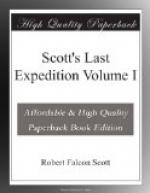Saturday, December 10.—Dead Reckoning 66 deg. 38’. Long. 178 deg. 47’. Made good S. 17 W. 94. C. Crozier 688’. Stayed on deck till midnight. The sun just dipped below the southern horizon. The scene was incomparable. The northern sky was gloriously rosy and reflected in the calm sea between the ice, which varied from burnished copper to salmon pink; bergs and pack to the north had a pale greenish hue with deep purple shadows, the sky shaded to saffron and pale green. We gazed long at these beautiful effects. The ship made through leads during the night; morning found us pretty well at the end of the open water. We stopped to water ship from a nice hummocky floe. We made about 8 tons of water. Rennick took a sounding, 1960 fathoms; the tube brought up two small lumps of volcanic lava with the usual globigerina ooze.
Wilson shot a number of Antarctic petrel and snowy petrel. Nelson got some crustaceans and other beasts with a vertical tow net, and got a water sample and temperatures at 400 metres. The water was warmer at that depth. About 1.30 we proceeded at first through fairly easy pack, then in amongst very heavy old floes grouped about a big berg; we shot out of this and made a detour, getting easier going; but though the floes were less formidable as we proceeded south, the pack grew thicker. I noticed large floes of comparatively thin ice very sodden and easily split; these are similar to some we went through in the Discovery, but tougher by a month.
At three we stopped and shot four crab-eater seals; to-night we had the livers for dinner—they were excellent.
To-night we are in very close pack—it is doubtful if it is worth pushing on, but an arch of clear sky which has shown to the southward all day makes me think that there must be clearer water in that direction; perhaps only some 20 miles away—but 20 miles is much under present conditions. As I came below to bed at 11 P.M. Bruce was slogging away, making fair progress, but now and again brought up altogether. I noticed the ice was becoming much smoother and thinner, with occasional signs of pressure, between which the ice was very thin.
’We had been very carefully into all the evidence of former voyages to pick the best meridian to go south on, and I thought and still think that the evidence points to the 178 W. as the best. We entered the pack more or less on this meridian, and have been rewarded by encountering worse conditions than any ship has had before. Worse, in fact, than I imagined would have been possible on any other meridian of those from which we could have chosen.
’To understand the difficulty of the position you must appreciate what the pack is and how little is known of its movements.
’The pack in this part of the world consists (1) of the ice which has formed over the sea on the fringe of the Antarctic continent during the last winter; (2) of very heavy old ice floes which have broken out of bays and inlets during the previous summer, but have not had time to get north before the winter set in; (3) of comparatively heavy ice formed over the Ross Sea early in the last winter; and (4) of comparatively thin ice which has formed over parts of the Ross Sea in middle or towards the end of the last winter.




